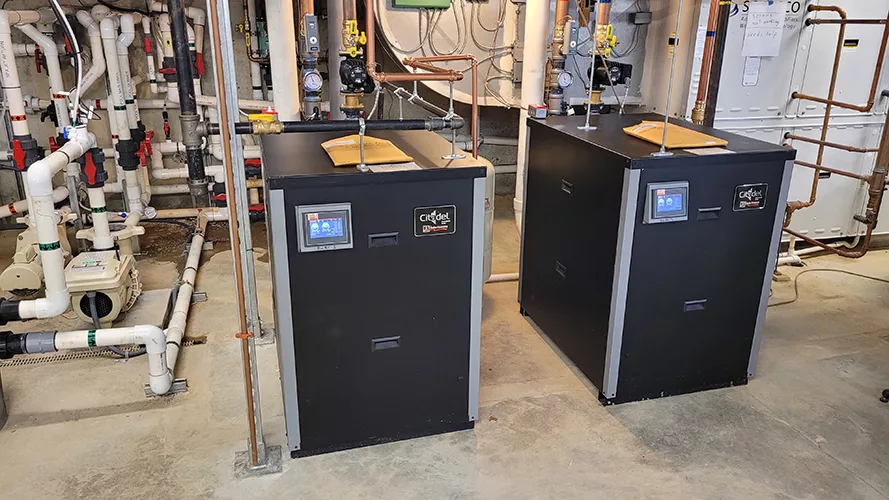As heating contractors, we do ourselves and our customers a serious disservice when approaching potential boiler replacement projects with a narrow view. We should begin each project with an open mind, look carefully at the whole system and ask ourselves: What’s the absolute best solution I can provide, regardless of whether I think the customer has the budget for it? The customer can always ask for a lower-cost alternative.
A project we recently completed serves as a fine example.
In October, we were referred to a housing community in New Jersey experiencing serious issues at its recreation center. The indoor pool and spa weren’t maintaining temperature, nor was the in-slab radiant system around the pool deck.
The air-side heating and dehumidification system was underperforming as well. The all-glass natatorium didn’t have the comfort level needed, and the customer was very concerned about how bad the problem would get with winter looming.
Offer the Premium Solution
I visited the site with Richard Zalepa, our service director, for a consultation (we bill for these visits).
Rather than heading straight for the boiler to simply write a replacement estimate, Zalepa and I spent several hours looking at various mechanical components. We found two independent boiler systems.
The pool and spa were heated by a 399 MBH condensing boiler, which doubled as the radiant heat source to the concrete pool deck. It had been installed 18 months earlier and was in good condition, but the piping to the heat exchangers and six-port radiant manifold had not been designed or installed well.
The water-to-water heat exchangers (two for the pool and two for the spa) were piped in series instead of reverse-return. Pipe sizes were wrong, and low-temp zones came off the primary loop before high-temp zones.
Additionally, despite the boiler being of sufficient capacity, its onboard control package couldn’t provide what the system needed. We needed more control than simply specifying a fixed delta T.
It became clear that the contractor who installed the boiler had removed the previous conventional boiler, dropped in a condensing boiler, and made no other improvements or changes to the 20-year-old system. The retrofit had been conducted without regard for temperature differentials, heating loads, pipe sizes, etc.
The second boiler, which provided capacity for the air-side heating and dehumidification system, was separate from the pool and radiant system. One 280 MBH fan coil was served by a five-year-old, 399 MBH high-efficiency boiler. When we pulled the cover, we found that the unit was leaking due to a complete lack of maintenance. Based on the condition of the boiler and the layout of the piping, it likely never condensed.
Instead of proposing both boilers be swapped for new units, Zalepa and I designed a central boiler plant to serve all the heating loads. If the customer accepted it, this approach would provide redundancy, higher efficiency, greater turndown ratio and the ability to concentrate heating capacity where and when needed.
The customer wasted no time in accepting our bid. Why? Because we resolved to fix every one of its pain points, in addition to providing benefits it wasn’t even aware of.
Over the course of a week, Zalepa, Thomas J. Soukup (my son) and installation tech Joey Mundorff made all the improvements we had promised in our proposal.
We started with two 399 MBH U.S. Boiler Co. Citadel condensing boilers. Cascaded together, they served each zone in the now-combined water-side and air-side systems. These boilers came with an extended 10-year warranty and Concert controls — an integrated commercial control package onboard the Citadel.
Setpoint controls were used for the pool, spa, radiant and air handler, allowing the two boilers to operate in lead-lag configuration, as well as modifying the supply water temperature for the air-side zone based on outdoor reset. The radiant zone uses a fixed water supply temperature, as we reused the existing Taco Radiant Mixing Block to manipulate in-slab water temperatures based on its outdoor reset sensor.
Roughly 90 percent of the piping (everything accessible) across both hydronic systems was torn out and replaced with larger, primary-secondary piping. Two of the four pool/spa heat exchangers were replaced with EJ Bowman titanium models. The other two were rebuilt. For the first time since it was constructed, the natatorium was also equipped with properly sized ECM circulators.
Customer and Contractor benefits
The customer was thrilled with the result. Comfort levels are the highest they’ve ever been, and there are no emergencies.
So, what did we deliver beyond peace of mind and comfort?
At a minimum, the facility will see a 20% reduction in energy consumption thanks to the 98% efficiency of the Citadel boilers.
The customer also benefits from boiler redundancy and greater system responsiveness. There’s now a single point of maintenance and better system turndown. The facility has a 10-year manufacturer’s warranty and a three-year preventative maintenance package we provide with our new systems. We also salvaged the existing pool boiler for later installation at one of the small outdoor pools.
What started as a small service call evolved into a six-figure retrofit.
With the value we communicated and delivered, the job cost increased 40 times simply because we looked at the big picture and presented the customer with a premium option that solved all its issues and then some.
Not every customer is willing or able to invest in the absolute best solution, but none of them will if you don’t offer it.





